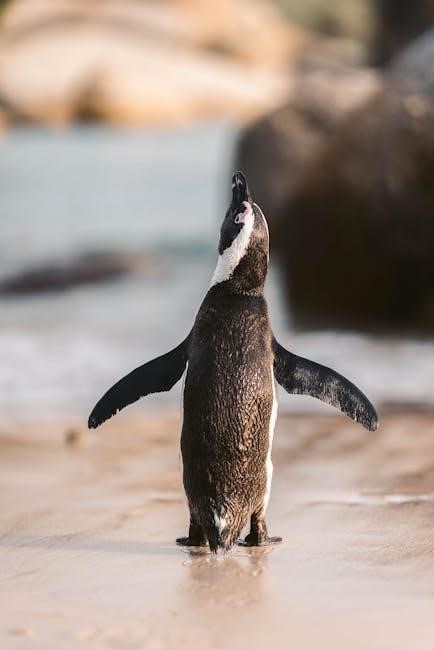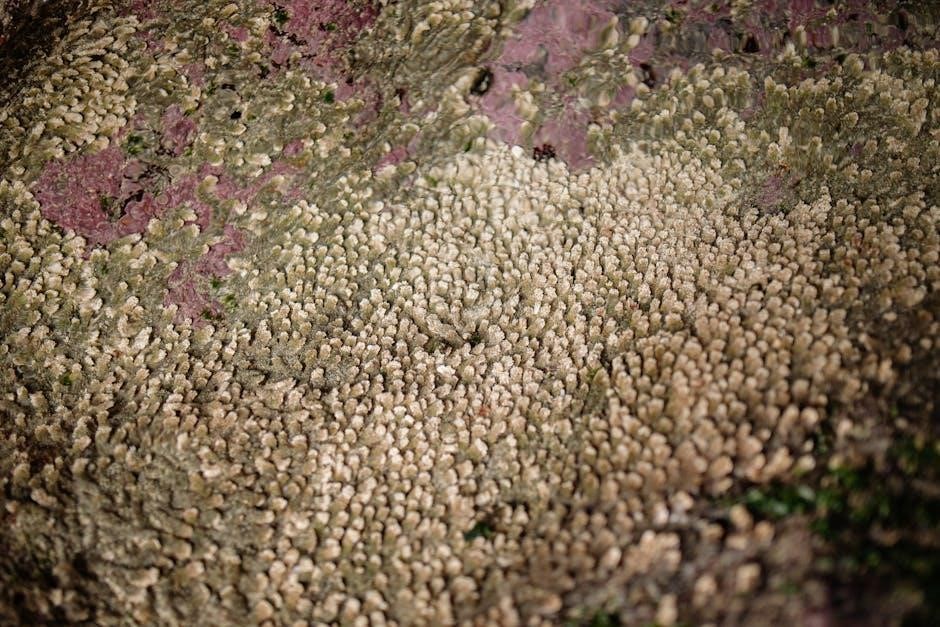Conservation biology focuses on preserving biological diversity by addressing threats like habitat loss and climate change. It integrates ecology, genetics, and ethics to protect ecosystems and species.
1.1 Definition and Scope of Conservation Biology
Conservation biology is a scientific discipline focused on understanding and addressing threats to biodiversity. It aims to preserve species, ecosystems, and genetic diversity. The scope includes ecological, evolutionary, and social dimensions, emphasizing the protection of natural systems. Conservation biologists address extinction risks, habitat degradation, and human impacts. The field integrates biology, ecology, and policy to develop strategies for sustainable coexistence between humans and nature. Its primary goal is to maintain ecological integrity and ensure the survival of diverse life forms.
1.2 Importance of Biodiversity
Biodiversity is essential for maintaining healthy ecosystems, providing essential services like clean water, air, and food. It enhances ecological resilience, allowing systems to recover from disturbances. Diverse ecosystems support pollination, nutrient cycling, and climate regulation. Biodiversity also offers cultural, recreational, and medicinal benefits. Protecting it ensures the survival of species and maintains the balance of nature. Conservation efforts focus on preserving this diversity to sustain life and support human well-being. Biodiversity’s loss threatens ecosystem stability, highlighting the urgency of conservation actions.
1.3 Key Concepts in Conservation Biology
Conservation biology revolves around core concepts like biodiversity, genetic diversity, and species extinction; It emphasizes the importance of ecological processes and the role of humans in biodiversity loss. Key principles include the need to maintain viable populations, preserve habitat connectivity, and address invasive species. Genetic variation is crucial for species adaptability and survival. Conservation strategies often focus on preventing extinctions and restoring ecosystems. Understanding these concepts is vital for developing effective conservation plans and ensuring the long-term sustainability of life on Earth. These principles guide actions to protect biodiversity at all levels.

The Biodiversity Crisis

The biodiversity crisis underscores rapid species extinctions and ecosystem decline, driven by habitat loss and human impact, threatening global ecological stability.
2.1 Current State of Global Biodiversity
The current state of global biodiversity is alarming, with species extinction rates accelerating due to habitat destruction, climate change, and human activities.
Ecosystems worldwide face significant threats, leading to a sharp decline in biodiversity.
Conservation efforts are critical to mitigate these impacts and preserve ecological balance.
2.2 Causes of Biodiversity Loss
The primary causes of biodiversity loss include habitat destruction, climate change, invasive species, and overexploitation of resources.
Human activities such as deforestation, urbanization, and agriculture have led to widespread habitat fragmentation.
Climate change exacerbates these impacts by altering ecosystems and disrupting species’ survival strategies.
Invasive species often outcompete native organisms, further threatening biodiversity.
These factors collectively accelerate species extinctions and ecosystem degradation.
2.3 Consequences of Biodiversity Decline
Biodiversity decline disrupts ecosystems, leading to reduced resilience and ecological instability. Loss of species impairs essential services like pollination, nutrient cycling, and carbon sequestration. Cascading effects weaken food webs, diminishing ecosystem health. This decline also increases vulnerability to invasive species and climate change. Decreased water quality and reduced agricultural productivity are additional concerns. Ultimately, biodiversity loss jeopardizes human well-being by impairing resources critical for survival and economic stability. Ecosystems with lower diversity are more vulnerable to environmental changes, threatening both natural systems and human societies.

Threats to Biodiversity
Biodiversity is threatened by habitat loss, climate change, invasive species, and overexploitation of resources. These factors disrupt ecosystems and accelerate species extinction, undermining ecological stability globally.
3.1 Habitat Loss and Fragmentation

Habitat loss and fragmentation are primary threats to biodiversity, driven by deforestation, urbanization, and agriculture. These processes reduce habitat size and isolate species, leading to population decline and reduced genetic diversity. Fragmented habitats hinder species migration and disrupt ecosystems, increasing vulnerability to extinction. Conservation efforts focus on restoring habitats and creating connectivity to mitigate these impacts and safeguard biodiversity. Addressing habitat loss is critical for maintaining healthy ecosystems and ensuring species survival.
3.2 Climate Change and Its Impact
Climate change significantly impacts biodiversity by altering ecosystems, disrupting species interactions, and shifting habitats. Rising temperatures cause phenological mismatches, while extreme weather events stress species survival. Polar and coral reef ecosystems are particularly vulnerable, facing habitat loss and species extinctions. Climate change exacerbates existing threats like invasive species and disease spread. Conservation strategies must incorporate climate resilience, such as assisted migration and habitat restoration, to help species adapt to these rapid environmental changes and mitigate biodiversity loss.
3.3 Invasive Species and Ecosystem Disruption

Invasive species disrupt ecosystems by outcompeting native species for resources, altering habitats, and introducing new predators or diseases. These non-native organisms often thrive due to the absence of natural predators, leading to ecological imbalances. For example, zebra mussels in freshwater ecosystems and kudzu in terrestrial habitats exemplify the destructive potential of invasive species. Their spread accelerates biodiversity loss, economic damage, and ecosystem degradation. Effective management requires early detection, eradication efforts, and restoration of affected habitats to mitigate long-term ecological consequences.
3.4 Overexploitation of Resources
Overexploitation of resources, driven by human activities like overfishing, logging, and hunting, depletes species populations and ecosystems. This unsustainable use often stems from economic demands, leading to resource collapse. For instance, overfishing disrupts marine food webs, while excessive logging erodes forest biodiversity. Such practices threaten species survival and ecosystem stability, necessitating sustainable management and policy interventions to balance human needs with conservation goals. Addressing overexploitation requires global cooperation and equitable solutions to prevent irreversible ecological damage.
Conservation Strategies
Conservation strategies include habitat restoration, species reintroduction, legal frameworks, and community-based initiatives to protect biodiversity and ecosystems effectively.
4.1 Habitat Restoration and Management
Habitat restoration involves rebuilding degraded ecosystems to support biodiversity. Techniques include reintroducing native species, controlling invasive plants, and recreating natural conditions. Active management ensures long-term sustainability, addressing climate impacts. Monitoring and community involvement are key to success. Restoring habitats like wetlands and forests helps species recover and ecosystems thrive, countering biodiversity loss effectively.
4.2 Species Conservation and Reintroduction Programs
Species conservation focuses on protecting endangered species through targeted interventions. Reintroduction programs involve releasing captive-bred individuals into the wild to restore populations. These efforts aim to prevent extinction, enhance genetic diversity, and reintegrate species into their ecosystems. Success requires careful planning, habitat suitability, and community engagement. Such programs also address human-wildlife conflicts and promote coexistence, ensuring long-term survival of species and maintaining ecological balance.
4.3 Legal and Policy Frameworks for Conservation
Legal and policy frameworks are essential for effective conservation. Laws such as the Endangered Species Act and international agreements like CITES regulate species protection and trade. These frameworks provide guidelines for managing threatened species, controlling invasive species, and enforcing habitat protections. Policies also promote sustainable practices and ensure compliance with conservation goals. International cooperation and organizations play a crucial role in harmonizing efforts and addressing global biodiversity challenges.

4.4 Community-Based Conservation Initiatives
Community-based conservation engages local populations in protecting biodiversity, fostering stewardship and sustainable land use. These initiatives empower communities to manage natural resources, balancing human needs with ecological preservation. Education and participation are key, ensuring that conservation aligns with cultural values and economic realities. Successful programs often integrate traditional knowledge with scientific practices, creating mutually beneficial outcomes for both people and the environment. This approach enhances conservation effectiveness by addressing local challenges and fostering long-term commitment to biodiversity protection.

Ecosystem Approach in Conservation
The ecosystem approach focuses on managing ecosystems as functional units, emphasizing sustainable use and conservation of ecological integrity to maintain biodiversity and resilience.
5.1 Principles of Ecosystem Management
Ecosystem management emphasizes sustainable practices to maintain ecological integrity and biodiversity. Key principles include integrating human activities with natural processes, conserving ecosystem services, and promoting resilience. Adaptive management, based on monitoring and feedback, is crucial. It involves collaborative decision-making, considering long-term ecological health and socioeconomic benefits. Ecosystem management also addresses threats like habitat fragmentation and climate change, ensuring sustainable use of resources while preserving ecological balance for future generations.
5.2 Ecological Diversity and Its Significance
Ecological diversity refers to the variety of ecosystems, habitats, and ecological processes within a region. It is vital for maintaining biodiversity, as different species rely on specific habitats for survival. Ecological diversity enhances ecosystem resilience, allowing systems to recover from disturbances. It also supports essential services like water purification and carbon sequestration. Protecting ecological diversity ensures the stability and functionality of ecosystems, making it a cornerstone of conservation biology. Without it, the intricate web of life faces disruption, leading to irreversible environmental changes.
5.3 Case Studies of Successful Ecosystem Conservation
Successful ecosystem conservation efforts highlight the importance of targeted strategies. For instance, the restoration of forest habitats in the Philippines has led to the recovery of endangered bird populations. Similarly, community-based initiatives in Africa have protected vital water sources and biodiversity hotspots. These case studies demonstrate the effectiveness of combining habitat restoration, species monitoring, and local engagement. They underscore the need for adaptive management and collaboration to achieve long-term conservation goals, ensuring ecosystems remain resilient and functional for future generations.
Genetic Diversity and Conservation
Genetic diversity is essential for species adaptation and survival, ensuring resilience to environmental changes. Conservation efforts focus on preserving this diversity to maintain healthy, adaptable populations.
6.1 Importance of Genetic Variation
Genetic variation within species is crucial for adaptation and survival, enabling populations to respond to environmental changes. It enhances resilience to diseases and ecological shifts, ensuring long-term viability. Conservation efforts prioritize genetic diversity to maintain healthy, adaptable populations. Loss of genetic variation can lead to reduced fitness and increased extinction risk. Protecting genetic resources is vital for preserving evolutionary potential and ecosystem stability. Conservation strategies often include safeguarding genetic diversity to ensure species can thrive in changing environments.
6.2 Threats to Genetic Diversity
Genetic diversity faces threats from habitat loss, inbreeding, and climate change, which reduce population sizes and isolate groups. Human activities like overexploitation and invasive species further disrupt genetic variation. Pollution and environmental changes also impact genetic health. Small populations often experience genetic drift, eroding diversity. Conservation efforts must address these threats to maintain robust genetic resources. Without intervention, species may lose adaptive potential, increasing extinction risks. Protecting genetic diversity requires targeted strategies to mitigate these pressures and safeguard evolutionary resilience.
6.3 Conservation of Genetic Resources
Conservation of genetic resources involves protecting and managing genetic diversity through ex situ and in situ methods. Ex situ techniques include seed banks, cryopreservation, and DNA banking, while in situ approaches focus on maintaining populations in their natural habitats. Protected areas and breeding programs help preserve genetic variation. Advanced technologies like gene editing can aid in restoring lost diversity. These strategies aim to safeguard genetic diversity, ensuring species can adapt to environmental changes and survive future challenges. Effective conservation requires coordinated efforts to protect genetic resources for long-term biodiversity.
Wildlife Management and Conservation
Wildlife management focuses on protecting endangered species and maintaining healthy ecosystems. Techniques include census taking, habitat restoration, and reintroduction programs to ensure species survival and ecological balance.
7.1 Goals of Wildlife Management Programs
Wildlife management programs aim to maintain healthy populations of species and restore ecosystems. These initiatives focus on preventing extinctions, ensuring genetic diversity, and preserving ecological functions. They also address human-wildlife conflicts and promote sustainable resource use. By integrating ecological principles and community engagement, these programs strive to balance conservation with human needs, ensuring biodiversity and ecosystem services are maintained for future generations. Effective management requires continuous monitoring and adaptive strategies to address emerging threats.
7.2 Techniques in Wildlife Conservation
Wildlife conservation employs various techniques to protect and manage species. Habitat restoration and species reintroduction programs are critical for reviving threatened populations. Genetic diversity management ensures robust populations, while monitoring and research inform adaptive strategies. Anti-poaching efforts and conflict mitigation address direct threats. Community engagement fosters support for conservation goals. These methods aim to restore ecological balance, ensuring species survival and ecosystem health. By combining science and community involvement, effective wildlife conservation safeguards biodiversity for future generations.
7.3 Ethical Considerations in Wildlife Management
Ethical considerations in wildlife management involve balancing human needs with animal welfare and ecosystem integrity. Decisions often weigh species preservation against economic or social interests. Conservation biologists must address ethical dilemmas, such as culling invasive species or relocating wildlife for human safety. Ensuring transparency and public engagement in decision-making processes is crucial. Respect for animal rights and ecological balance guides ethical practices, promoting sustainable and morally justifiable outcomes in wildlife conservation efforts.
Future directions in conservation biology emphasize emerging technologies, global collaboration, and public awareness to address biodiversity crises. Innovations and education are key to sustainable solutions. Emerging technologies are transforming conservation efforts, offering innovative solutions to biodiversity challenges. Advanced monitoring systems, such as camera traps and acoustic sensors, enable real-time tracking of species and habitats. Artificial intelligence (AI) and machine learning analyze large datasets to predict extinction risks and optimize conservation strategies. Drones and satellite imaging provide high-resolution data for habitat mapping and deforestation surveillance. Additionally, gene-editing tools like CRISPR may help restore genetic diversity in endangered populations. These technologies, when combined with traditional methods, enhance efficiency and scalability in conservation practices globally. International cooperation is vital for addressing global biodiversity challenges, as conservation efforts transcend national borders. Treaties like the Convention on Biological Diversity (CBD) and the Paris Agreement foster collaboration among nations to protect ecosystems and species. Global initiatives, such as the United Nations’ Sustainable Development Goals (SDGs), emphasize the importance of collective action to combat biodiversity loss. By sharing resources, knowledge, and strategies, countries can achieve more effective conservation outcomes than individual efforts alone, ensuring a unified approach to safeguarding Earth’s biological diversity. Public awareness and education are crucial for fostering support for conservation efforts. Educating communities about biodiversity’s importance helps encourage sustainable practices and environmental stewardship. Outreach programs, media campaigns, and school curricula play key roles in disseminating knowledge. By engaging the public, conservationists can build a collective commitment to protecting ecosystems and species. Awareness initiatives also promote advocacy, leading to policy changes and grassroots movements that contribute to long-term biodiversity preservation. Empowering individuals with knowledge is essential for creating a society invested in conservation.
Future Directions in Conservation Biology
8.1 Emerging Technologies in Conservation
8.2 Role of International Cooperation

8.3 Public Awareness and Education